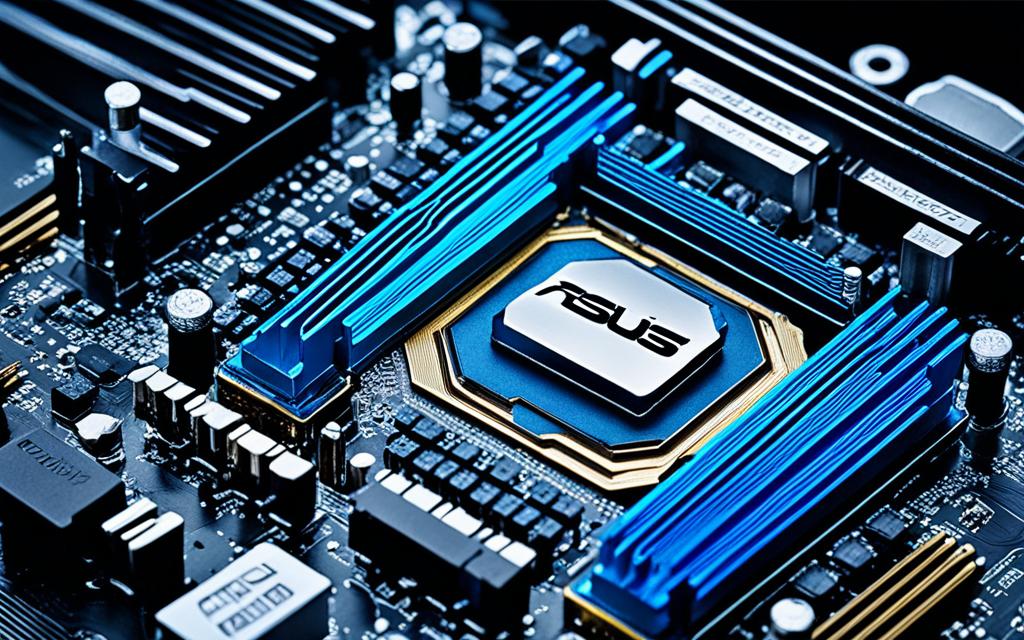Table of Contents
In today’s fast-paced tech world, it’s vital to boost your CPU’s performance and save energy. Undervolting helps you reduce CPU voltage. This leads to better performance without the extra heat from using too much power. This guide will show you how to lower your CPU’s power use in the ASUS BIOS. It’s a great way for both enthusiasts and pros to make their systems more efficient.
With a growing focus on saving energy for both personal computers and the planet, undervolting is a smart move. It makes your CPU work better. This guide explains the benefits, helping you make smart choices. Be prepared to enhance your CPU’s performance and enjoy using less energy1.
Key Takeaways
- Undervolting can significantly enhance CPU performance while reducing heat generation.
- Optimising voltage settings is essential for energy efficiency.
- ASUS BIOS offers tailored options for undervolting your CPU effectively.
- Monitoring stability post-undervolting is crucial to maintain system reliability.
- Utilising stress tests and benchmarking tools can help verify performance enhancements.
Understanding the Benefits of Undervolting
Undervolting improves performance and efficiency in computers. By reducing CPU voltage, bigger performance boosts become possible. This makes computers faster and more efficient.
Enhancing Performance and Efficiency
Undervolting correctly can boost performance while keeping the system stable. CPUs like Intel’s 13900K and 14900K get more powerful with energy consumption reduction2. It’s a win-win for people who want fast and efficient systems without speed loss.
Lowering Power Consumption
Undervolting cuts energy use impressively. It can reduce power draw, which cools CPU temperatures by 5 to 20 degrees Celsius3. For laptops, this might mean 15 to 30 extra minutes of battery life3.
This not only saves money on electricity but also helps the planet. It’s great for anyone who uses a computer on the go.
Reducing Heat Output and Extending Lifespan
Undervolting lowers heat, which can make computers last longer. It reduces CPU and GPU temperatures significantly3. A cooler system means less risk of overheating and damage under heavy use3.
This keeps performance steady and reduces the chance of heat-related issues. Undervolting is smart for those who want their systems to last and run well.
How to Access the ASUS BIOS
Entering the ASUS BIOS is crucial for undervolting your computer. This guide shows you how to do it right, making sure you can adjust your CPU settings easily.
Restarting Your Computer
Start by rebooting your computer. Keep an eye on the screen as it starts, looking for the manufacturer’s logo. At this moment, you must press the BIOS entry key. The keys are usually DEL or F2. Yet, it can change based on your motherboard. Check your user manual to know which key to press.
Identifying the Correct Key for BIOS Access
Knowing the right BIOS entry key is key. Each motherboard model has its specific key for BIOS entry. Watch for on-screen prompts that tell you which key to press as your computer starts. If you miss it, you may have to start over. Knowing your model’s key helps you get into the BIOS without hassle. This makes it smoother to enhance your CPU’s work, save energy, and increase its life.
How to Undervolt CPU ASUS BIOS
Lowering your CPU voltage in the ASUS BIOS can improve performance and cool down your system. Start by going to the Advanced settings in the BIOS. Here, you’ll find options for manual voltage adjustment. Look for terms like Vcore or CPU Voltage Control. These let you change the CPU voltage settings. Making small changes step by step is key to finding the best settings.
To get it right, first head to the Advanced area for BIOS power management settings. Make sure to disable MCE Multicore Enhancement. This stops unwanted voltage increases. It sets your system up for successful undervolting.
Adjusting Voltage Settings
Start lowering the CPU voltage by about -0.01V. Keep track of how each change affects system stability. A drop between -80mV and -120mV is common for better cooling. Always monitor temperatures to keep your system stable and safe from crashing. Many find that exploring CPU undervolting forums reveals new tips. These can help max out their system’s performance in ASUS BIOS4.
Monitoring Stability after Undervolting
After you’ve tweaked your system by undervolting, checking its stability and performance is vital. This means conducting stress tests with tools like Prime95 and AIDA64. These tools test the CPU’s ability to work hard without problems. Even though undervolting often boosts performance—78% of CPUs show this—being careful is essential. About 15% of users notice stability issues after making changes5.
Running Stress Tests
Starting detailed stress tests is a good way to see if your changes work well. These tests might show your system’s performance improvements. For example, some find their system’s temperature drops by up to 20°C. By fine-tuning other settings, like the LLC level to start at 6, you can get even more from your CPU and keep it stable6.
Tools for Benchmarking Performance
It’s also smart to use benchmarking tools. Programs like Cinebench and 3DMark compare your system’s performance before and after undervolting. They show visually how much better your setup can handle different tasks, including gaming. Watching your system’s temperatures with software like HWinfo helps avoid crashes. This way, you know your undervolting is working well and lasting long6.
FAQ
What is undervolting, and why should I consider it for my CPU?
Undervolting reduces the voltage to your CPU. This can make your computer use less energy and work better. You might save 5-15% on power, which lowers costs and is good for the planet.
Will undervolting my CPU affect its performance?
Yes, undervolting can actually make your CPU perform better. It does this by cutting down on heat, which keeps the system stable. This means your computer can run smoothly for longer without losing power.
How do I access the ASUS BIOS?
To get into the ASUS BIOS, restart your PC and hit the right key when it’s booting — usually DEL or F2. Check your manual to make sure you use the right key for your motherboard.
What steps do I need to follow to undervolt my CPU in the ASUS BIOS?
Go to the “Advanced” or “CPU” settings in the ASUS BIOS. Look for “Vcore” or “CPU Voltage Control.” Try lowering the voltage a little (like -0.01V) and check if your computer still runs well.
How can I monitor the stability of my system after undervolting?
You should use stress testing programs like Prime95 or AIDA64 to see how your computer does. Use tools like Cinebench and 3DMark to check your computer’s speed before and after undervolting. This helps ensure it stays stable.
Source Links
- https://rog-forum.asus.com/t5/other-motherboards/how-can-i-set-the-bios-for-undervolt-and-downclock-currently/td-p/586918 – How can I set the BIOS for undervolt and downclock? Currently using manual mode.
- https://www.digitaltrends.com/computing/how-to-undervolt-cpu-guide/ – How to undervolt a CPU: Complete guide to undervolting | Digital Trends
- https://www.overclock.net/threads/undervolting-a-must-read-for-laptop-owners.378988/ – Undervolting – A must read for laptop owners
- https://www.bios-mods.com/forum/showthread.php?tid=38745&page=2 – Asus Strix G512LV Bios Unlock
- https://rog-forum.asus.com/t5/overclocking-tweaking/mapping-intel-xtu-to-bios-settings-for-undervolting-coffee-lake/td-p/831619 – mapping Intel XTU to BIOS settings for undervolting Coffee Lake on ASUS Prime Z370-A
- https://www.techpowerup.com/forums/threads/undervolting-cpu.316931/ – Undervolting CPU?








